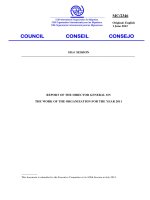the giant lives on
Bạn đang xem bản rút gọn của tài liệu. Xem và tải ngay bản đầy đủ của tài liệu tại đây (32.44 KB, 3 trang )
Daily
1Ben DailyCarolyn KremersEnglish 213-002February 10, 1997
The
Giant Lives On Every time I read the Tlingit Legend, "How
Mosquitoes Came To Be," there are certain questions that come to mind
about where the legend came from and who wrote it. The legend was
first published in 1883 and later found by Richard Erdoes, who included it
in one of his publications, American Indian Myths and Legends. Why is
the human race so selfish to think we can be the hunter and not the
hunted. Although giants could be a dominant presence in our lives,
humans prove that they will not be over-taken. Each time I read the
Tlingit legend, a new question would arise in my mind as to how this
legend came to be and particularly, who wrote it? The first question I
thought of was, is he the only giant on the planet? This was answered
for me with the introduction of the giant's son. As I read on, something
seemed puzzling to me, the fact that why humans are so selfish to think
they are better than giants, let alone anything else. For instance, why is it
okay for humans to kill a chicken, roast it and eat it, and a giant is bad to
"kill humans, eat their flesh, and drink their blood"(11)? Later in the story
we learn that the giant also liked to roast the hearts of humans. Another
puzzling question I asked myself is, if the giant was stabbed by the
human and "The monster screamed and
Daily 2fell down dead."(12), why
did the giant still speak? I know this is a legend or maybe just a
fictionous story, but if the giant is also a spirit then that would be helpful
when reading the legend. I will analyze these questions in hopes of
understanding the problems with humans and giants, which I might add is
still being dealt with today with mosquitoes everywhere. My first
question, if this giant was the only one on the planet, seemed answered
toward the end of the story with the introduction of the giant's son. When
the human threatened the life of the boy giant as he asked where the
heart of his father was, why didn't he kill the boy anyway? As we all
know, a boy will eventually become a person, and the boy is in fact a
giant, therefore by killing the giant by stabbing him in the left heel, the
human simply forgot the son. There are a lot of parts in this legend that
are very unclear and when we ask why, who, what, where and when, we
are led into yet another question to be answered. Which leads me into
my next question, What makes a human better than a giant? In the
Tlingit legend, a human feels threatened by a giant and kills it, why? I
tend to think giants like to kill and eat humans, just as humans like to kill
and eat cows, chicken and other animals. So tell me gentle reader, what
is the difference? Is it that we are humans and we cannot be subject to
be hunted as we do other animals. The only explanation is that human
nature will only lead us to believe that we will not be overcome by
anything except ourselves. One possibility for the actions of the humans
against the
Daily 3giant would be that the giant can speak, and shows some
intelligence, after all he did build a home for his son and himself.
Therefore the humans might have thought that the giant was beyond
reasoning with, thus the basis for killing the giant. Another question that
poked at my brain was that even though the giant was declared dead, he
still spoke the words "Though I am dead, though you killed me, I am
going to keep eating on you and all the other humans in the world
forever"(12). Okay, maybe as he was dying he muttered those words, but
how do you explain the laughing as his ashes were being thrown into the
wind? If the giant was in fact burnt to ashes how could he possibly laugh
and talk to the human. My last argument is how the ending was abruptly
cut short and how it left the reader hanging without knowing what
happened to the giant's son. Also, if there is a boy giant, what about the
mother giant? I often questioned the credibility of this legend and the
author, but that is something that has to be considered when reading
"How Mosquitoes Came To Be." I did a little research about this legend,
curious about who wrote it and when exactly it was written. According to
the paragraph at the top of page 11 from the legend, the essay was first
published in 1883 in an English-language source and was found by
Richard Erdoes. Checking the gnosis system in the Rasmuson library for
several possibilities as to who and when the legend was written, I came
up short. This legend was a simple story about a small community
with a big problem. A giant who likes to eat people was a menace who
needed to be dealt with. One human decided to take matters into his own
hands and try to kill the giant himself. This human
Daily 4played opossum on
the trail of the giant and eventually was picked up by the giant. The giant,
unknowing that he was being set up to be killed, was overjoyed that he
could find a fresh human to feed upon. Throwing the human over his
shoulder, he finds his way back home and drops the person on the floor
and retreats outside to get some firewood. In the mean time the
human gets up off the floor and retrieves and huge knife that belonged to
the giant, just as the boy giant comes into the room. The human
immediately put the knife to the boy's throat, threatening to kill him if he
did not reveal the place of his father's heart. Scared from all of the
commotion that seemed to come from nowhere, the boy told the human
his father's heart was in his left heel. Just then, the giant walked into the
room, the person immediately stabbed the giant in the left heel. As the
giant collapsed he vowed to continue to eat humans until the end of time.
Foolishly, the human told the giant he would never allow the giant to do
such a thing and cut the giant into pieces and burnt him to ashes. The
human, thinking he has saved the human race, threw the ashes into the
wind. Just as the ashes were thrown into the air, they immediately turned
into mosquitoes and began to suck the human's blood. It seems that the
giant got the last laugh, continuing to eat humans until the end of time.
After reading this legend over and over, I find that looking beyond
all of the questions that have come to mind, I found the story to be a
change of pace verses the conventional ways about explaining the
creation of insects. Yet some parts of the legend seemed sketchy as to
how this chain of events took place. My biggest questions, which may
never be answered, are who started the legend and when it originated.
Overall I
Daily 5enjoyed the legend and the creativity, but after reading it
several times the questions began to jump out at me like crickets in the
night. Humans need to learn that we are not the only intelligent life on the
planet, and if we ever did come across any giants, we should try to act
rationale instead of rash.









